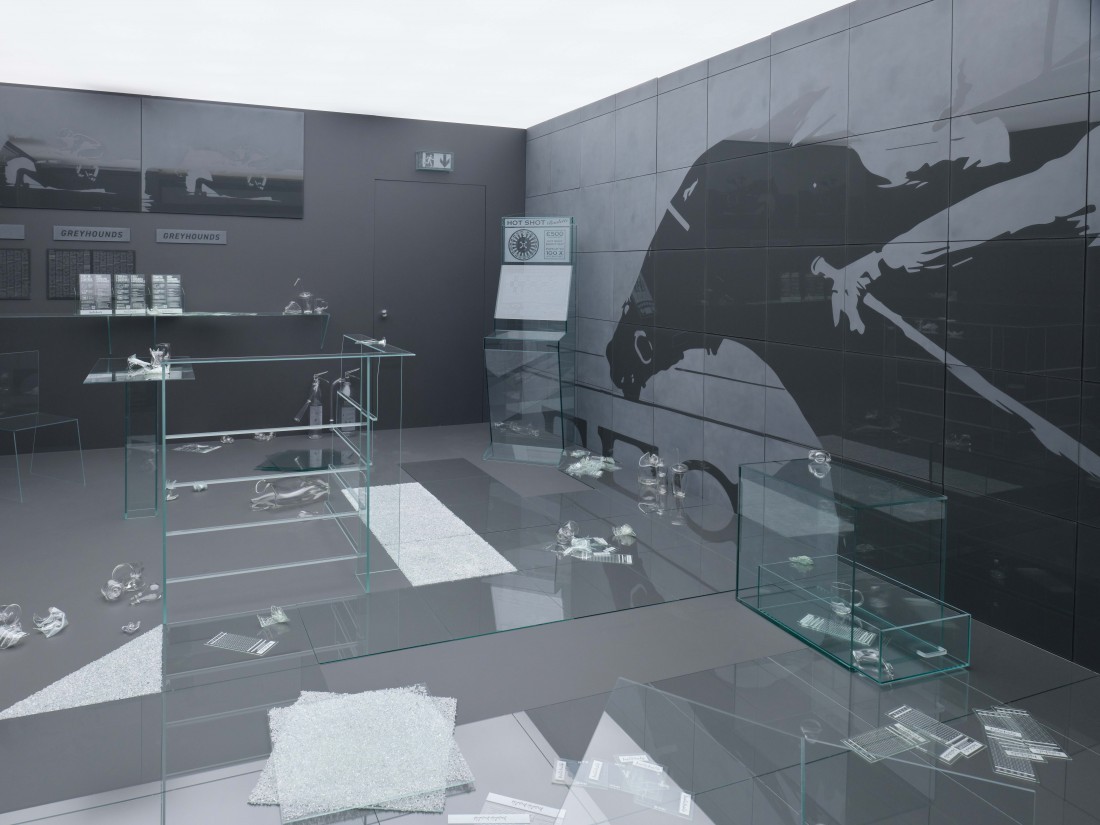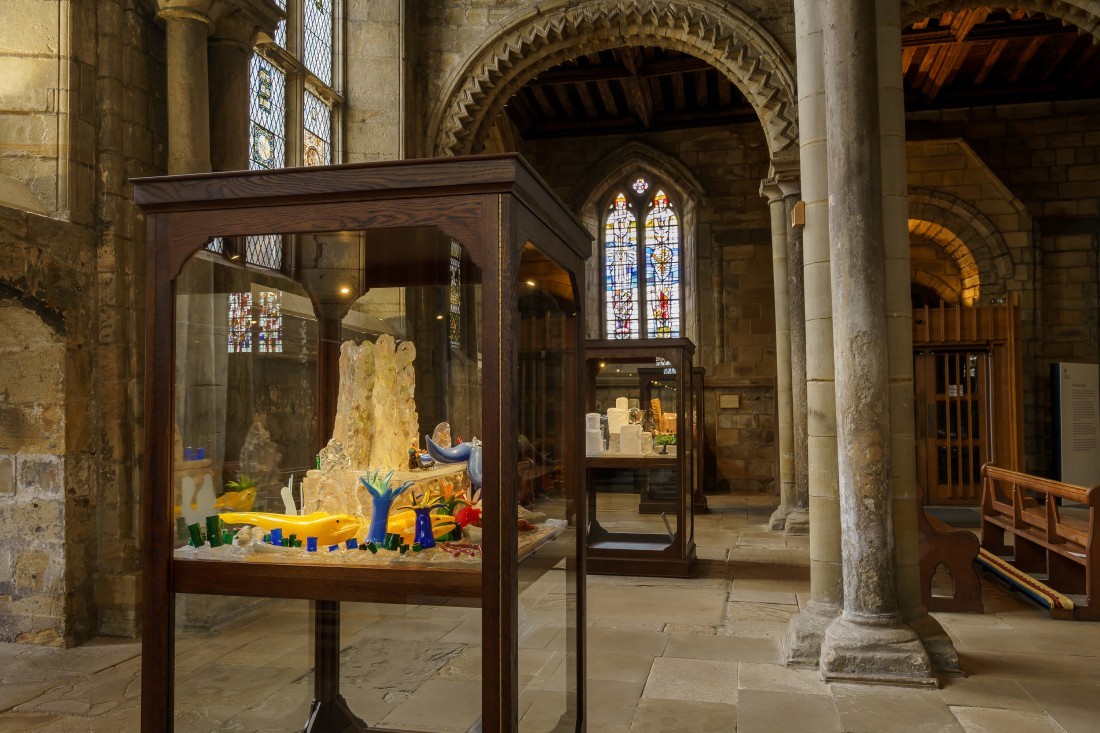“Glass Exchange”
The old distinctions between “art” and “craft” have been reduced sufficiently in recent years for ceramics and textiles to be regarded as mainstream. As an art material, glass hasn’t yet achieved comparable acceptance—I suspect that’s not down to lack of suitability but to the circumstances of its production: an expensive and potentially dangerous process that doesn’t feature in art degrees since colleges don’t have the facilities, and which generalist artists can realistically tackle only with access to specialist facilities and practitioners. But the UN has declared 2022 the International Year of Glass, which sounds like an opportunity.
Sunderland, in the northeast of England, is Britain’s leading location for glass: St Peter’s Church is believed to have been—in 674—the first in the world to commission a stained-glass window; a long tradition of manufacturing includes making almost all the world’s Pyrex; the National Glass Centre (NGC) has Britain’s most extensive facilities for studio glass, including water jet cutters capable of complex shapes. The Northern Gallery for Contemporary Art is set in the same glassy building on the banks of the River Wear, making Sunderland a logical place from which to develop what has been termed a “Glass Exchange,” bringing together the skills of specialist glass makers and four leading contemporary artists who haven’t worked in glass before.
Pascale Marthine Tayou sent some 120 colourfully stylized wooden figures, collected in his native Cameroon, for equivalents to be made in glass. They depict, for the tourist trade, characters from various professions. If the request was straightforward enough, the technical know-how and stamina needed to make what became 160 figures was considerable, with heads, clothing and limbs blown separately, and details such as ties drawn in with hot glass in a technique that master technician James Maskrey told me he had picked up from making lamps. Tayou had the figures mounted in groups of five, each quintet making up a cross, so that 32 crosses ran the length of the NGC’s Balcony Gallery. The effect was joyful but hid a serious point: Tayou says he wants the viewer to make connections between colonization and the growth of Christianity in Africa. You might, I suppose, depending on your ideological perspective, see Colonial Ghost as a critique of the presentation of Christianity as a superior religion when it came along with slavery and colonial oppression; or as indicating the achievement of a salvation beyond such worldly matters.

Ryan Gander, Ghost Shop, 2022. Photo: George Darrell. © Ryan Gander. Photos courtesy the National Glass Centre, Sunderland, UK.
A few miles away, Durham Cathedral’s Galilee Chapel is an appropriate setting for Monster Chetwynd—who has a Catholic background—to deal with Christian themes, especially as her subject, the Venerable Bede, is interred there. Again, though, it is the aesthetic impact that is primary. Her installation The Life of St. Bede consists of four glass dioramas in handsome wooden cabinets such as cathedrals traditionally use to display their treasures. They capture key scenes from the lives of local saints Bede and, through the fact that Bede wrote extensively about him, Cuthbert. First we see the Venerable Bede, 673–735, entering an iridescently gold monastery at the remarkably early age of six; then St Cuthbert of Lindisfarne, 634–687, casting out the devil from a magistrate’s wife, seen in a glass bubble. Next comes Cuthbert warmed by otters after wading in a freezing sea, such was his empathy with nature. Chetwynd concludes by showing Bede writing atop a pile of manuscripts, acknowledging his seminal influence as an author and thinker. He was, for example, the first to connect the moon with the tides, and popularized the notation “Anno Domini.” The combination of narrative elements in the round with a luminous and hypnotizing focus on details such as birds, flowers and slugs makes these dioramas sculpturally alluring. But why does Chetwynd want to focus on this particular story? Perhaps she is calling attention to a more straightforward, less technologically mediated, view of nature and mankind. We need a Bede and Cuthbert for our age.
Katie Paterson’s work is in an aumbry in the cathedral, which is to say a small recess in the wall for storing sacred vessels and vestments. This particular aumbry, empty due to the discontinuance of the chapel it used to serve, hosts the unobtrusive hourglass The Moment. It’s full of “cosmic dust,” which flows for 15 minutes each time the glass is turned, identified by Paterson as a suitable time to meditate on where we came from, on how “we are all made of star stuff.” The use of glass here is relatively simple, though various possible shapes were experimented with, and the calculation of size was complicated by the varying density of the different possible dusts in the coproduction of Paterson’s broader project, Requiem. That, shown at the Ingleby Gallery in Edinburgh, surrounds a large glass urn with 370 small vials, each containing 21 grams of powdered matter—the posited weight of a human soul. The vials of dust were poured into the urn, layer by layer, beginning with pre-solar dust from the oldest of meteorites, followed by a slow unfurling of planetary history, from the oldest earthly rock formations to the first life to the Holocene giving way to the Anthropocene: trinitite from the first atomic bomb detonation; fly ash from the burning of fossil fuels; regurgitated plastic from the body of a baby albatross. That’s the history we might reflect on in Durham Cathedral, as the vastness of the universe flows for a quarter of an hour.

Monster Chetwynd, The Life of St. Bede, 2022, Galilee Chapel in Durham Cathedral. Photo: David Wood.
So far, then, so good. And all three projects address systems of belief. But I’ve saved the best for last. A betting shop has closed on Sunderland High Street, and the lease is advertised. That’s not too surprising, but some passers-by take a second look, pressing against the window to see the detritus: adverts for available sports, a fixed odds betting terminal, race cards, dislodged carpet tiles, a rubber plant, fire extinguishers, those little pens, betting slips screwed up and thrown to the floor in the frustration of loss. But this is Ryan Gander’s Ghost Shop: all of it is made of glass, an evocative move that invites speculation via the relevant material qualities of glass—ethereality, fragility and transparency.
The ethereal effect picks up the intangible nature of many High Street “products”: much of what was on the High Street has departed to the virtual world, and much of what remains doesn’t fit the standard model wherein people emerge with physical goods: tanning salons, banks and barber as well as betting shops. The fragility of glass calls attention to the decline of British High Streets in the face of out-of-town shopping, online alternatives, cost pressures, transport issues. Gander sees that as a matter for regret, not so much because the alternatives don’t deliver, as because the social aspect of the High Street is threatened—and he’s spent plenty of time sitting outside his Ghost Shop discovering how friendly the locals are. The closure of shops also represents a reduction in potential human agency: traditional shopping isn’t just a matter of time and money but also choice, connection, empowerment and belonging. Moreover, the High Street might stand in for a wider malaise: has humanity’s position ever seemed as fragile as now? The transparency of glass has the most specific relevance to the choice of a betting shop. Gander mentions “the beckoning doors of illicit sin that betting shops have. They’re always covered—you never know what’s going on inside so there is all this mystery to them. The shops are places of heightened emotions—a mixture of adrenalin, inspiration, joy and desperation.” According to Gander, “We see betting shops but they are kind of invisible because we pay no attention to them. They just become deleted from our awareness. We cancel out other people’s problems with addictions … we just blank these things out. We make them transparent.” And there’s a different system of belief here: the conviction that the next bet will be the one that wins, when we know that the system is predicated on stakes exceeding winnings.
Where Gander scores is not just in the “wow factor” of the project but the way in which the unexpected use of glass triggers the potential meanings. Paterson’s glass is more straightforwardly functional, though it is in the service of a total project of comparable resonance. Chetwynd and Tayou make persuasive use of glass, but the material is less integral to their meanings: you could imagine a ceramic substitution, for example, working equally well. Looking more broadly, though, that may be where glass needs to be in the long term: a natural material for art, so that we don’t ask “why glass?” in a way we wouldn’t expect to ask “why a painting?” or “why a photograph?” ❚
“Glass Exchange,” four installations commissioned by the National Glass Centre in Sunderland, are on exhibition from March 26 to September 11, 2022.
Paul Carey-Kent is a freelance art writer and curator based in the New Forest, England. Go to his Instagram @paulcareykent to find out more.

